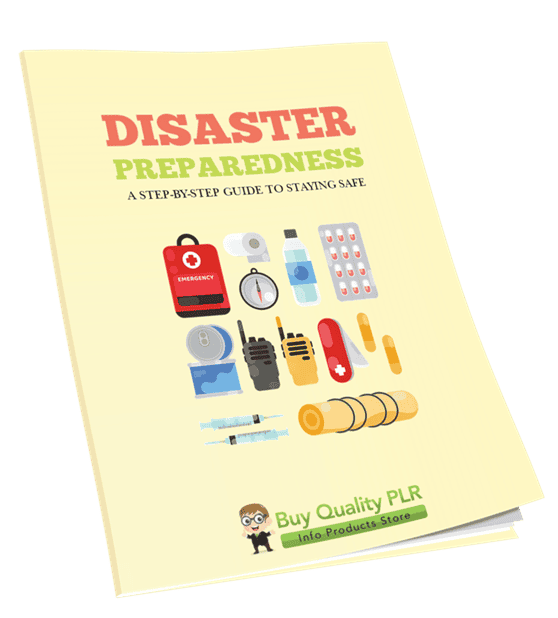
Disaster Preparedness PLR Course 21k Words
in PLR Checklists , PLR eBooks , PLR eCourses , PLR List Building Reports , Premium PLR , Premium PLR eBooks , Premium PLR Reports , Premium White Label Brandable PLR Coaching Courses , Private Label Rights Products , Survival PLR , Survival PLR eBooksChoose Your Desired Option(s)
has been added to your cart!
have been added to your cart!
#disasterpreparedness #emergencyplanning #survivaltips #crisismanagement #plrcourse #emergencypreparedness #preppingbasics #plrcontent
Disaster Preparedness: A Step-by-Step Guide to Staying Safe
Be Ready for Anything with Confidence!
Disasters can strike at any time, often without warning, and when they do, being prepared is the difference between chaos and control. Disaster Preparedness is your comprehensive guide to getting ready for any emergency—whether it’s a natural disaster like an earthquake, or a man-made crisis such as a power outage or chemical spill. This PLR course is designed to walk you through each essential step to ensure you and your loved ones are ready for whatever comes your way.
By the end of this course, you’ll have a solid disaster preparedness plan in place, from understanding the risks to setting up your emergency supply kit and recovery plan.
Presenting…
Disaster Preparedness PLR Course 21k Words
What’s Included in the Course?
This course offers you the knowledge and tools to stay safe, be prepared, and recover effectively in the event of a disaster. Every module is packed with vital information, practical steps, and real-world advice on how to prepare for, respond to, and recover from various types of emergencies.
Module Breakdown:
Module 1: Understanding Disasters and Their Impact
💡 Goal: Gain a clear understanding of disasters and why preparation is essential for safety.
- Step 1: Identifying Types of Disasters
Learn the different types of natural (earthquakes, floods) and human-made disasters (fires, chemical spills) and their potential impact on you and your community. - Step 2: How Disasters Affect Us
Understand the ripple effect of disasters: power outages, food shortages, and emotional distress. - Step 3: Recognizing Early Warning Signs
Learn how to stay ahead of disasters by recognizing weather alerts, emergency broadcasts, and other early warning signals. - Step 4: Why Preparation Matters
See how preparedness saves lives, reduces damage, and helps communities recover more effectively.
Module 2: Building Your Emergency Plan
💡 Goal: Create a personalized emergency plan for you and your family to act quickly and safely.
- Step 1: Creating a Family Emergency Plan
Develop a communication plan, establish meeting points, and assign roles to family members so everyone knows what to do. - Step 2: Preparing an Evacuation Plan
Learn how to choose safe routes, emergency exits, and transportation options for evacuation. - Step 3: Knowing Where to Get Reliable Information
Discover how to stay informed through news, radio, and trusted disaster response agencies. - Step 4: Practicing Your Plan
Conduct family drills regularly to ensure everyone is well-prepared for emergencies.
Module 3: Assembling a Disaster Supply Kit
💡 Goal: Build a comprehensive and practical emergency kit that will support you and your family during a disaster.
- Step 1: Essential Supplies for Survival
Pack food, water, first-aid items, flashlights, batteries, and other critical supplies. - Step 2: Personal and Medical Needs
Stock up on prescriptions, hygiene products, baby supplies, and pet essentials to ensure everyone’s well-being. - Step 3: Important Documents and Cash
Keep copies of IDs, insurance papers, and some emergency cash in a waterproof container. - Step 4: Storing and Maintaining Your Kit
Learn how to store your emergency kit properly and ensure items are always up to date with regular checks.
Module 4: Staying Safe During a Disaster
💡 Goal: Equip yourself with the knowledge to stay safe during various disaster scenarios.
- Step 1: How to Stay Safe Indoors
Learn how to protect yourself in case of earthquakes, tornadoes, or fires when you’re inside a building. - Step 2: How to Stay Safe Outdoors
Understand the safest places to take shelter during floods, lightning storms, or hurricanes. - Step 3: First Aid and Emergency Care
Learn basic first aid skills to treat injuries like cuts, burns, and fractures in the absence of immediate medical help. - Step 4: Helping Others in an Emergency
Discover how you can assist your neighbors, elderly relatives, and pets during a disaster to ensure everyone stays safe.
Module 5: Recovery and Rebuilding After a Disaster
💡 Goal: Learn how to assess damage, recover emotionally, and rebuild your life after a disaster.
- Step 1: Assessing Damage and Ensuring Safety
Understand how to check for structural damage and hazardous conditions before re-entering your home after a disaster. - Step 2: Seeking Help and Resources
Find out where you can access financial aid, food, and shelter assistance in the aftermath of a disaster. - Step 3: Coping with Emotional and Mental Health Effects
Learn how to manage the stress, grief, and trauma that often follow a disaster, and the importance of reaching out for help when needed. - Step 4: Strengthening Your Future Preparedness
Reflect on lessons learned during the disaster and make improvements to your emergency plan for the future.
Bonus Materials Included with Your Purchase
Along with the Disaster Preparedness PLR Course, you will receive the following valuable bonus materials:
- Disaster Preparedness Checklist
A 934-word checklist summarizing all of the crucial steps and tips from the course to keep you organized and prepared. - Disaster Preparedness FAQs
A 1,066-word FAQ covering common questions about disaster preparedness, common scenarios, and how to respond effectively. - Disaster Preparedness Sales Page
A 670-word ready-to-use sales page for selling this course to your audience.
Ways to Use & Profit from the Course
The Disaster Preparedness PLR Course offers multiple ways to profit, including:
- Sell the course as-is: Offer this valuable resource directly to customers via your website, email list, or social media channels.
- Create a membership site: Add this course as part of a paid membership site offering ongoing preparedness resources and updates.
- Repurpose into a video course: Convert this course into video lessons and offer it as a video-based training program.
- Use as a lead magnet: Offer parts of the course for free to build your email list and upsell the full course.
- Bundle with other survival and preparedness products: Increase the value of your offering by bundling this course with other related content.
Licensing Terms
The Disaster Preparedness PLR Course comes with full resale rights. You can:
- Sell the content as-is or modify it to suit your needs.
- Break it down into individual reports and sell them separately for $10-$20 each.
- Bundle it with other content to create high-value products for $47-$97.
- Create a membership site and offer ongoing disaster preparedness courses.
- Repurpose it into videos, audios, or written materials for maximum engagement.
- Use portions of the content as blog posts or lead magnets to attract and engage your audience.
What You Cannot Do with This Course
- Resell the PLR rights: You cannot give your customers the ability to resell the content or pass on PLR rights.
- Give away the course for free: The course must be sold. However, you may excerpt portions to use as lead magnets or blog posts.
- Offer 100% affiliate commissions: The maximum affiliate commission you can offer is 75%.
Get Prepared for Anything – Start Your Journey Now
The Disaster Preparedness PLR Course is your ultimate guide to staying safe and being prepared for any emergency. For just $14.99, you can equip yourself and your family with the knowledge and skills to handle any disaster situation.
Click here to purchase the Disaster Preparedness PLR Course and start building your emergency preparedness plan today!
has been added to your cart!
have been added to your cart!
Here A Sample of Disaster Preparedness PLR Course
Disasters can happen anytime, anywhere. Whether it’s a natural disaster like an earthquake or a man-made emergency, being prepared can make all the difference. This course will guide you through essential steps to protect yourself, your family, and your community. By the end, you’ll feel confident in handling emergencies with a clear action plan.
Module 1: Understanding Disasters and Their Impact
💡 Before we can prepare, we need to understand the different types of disasters and their effects on our lives.
Step 1: Identifying Types of Disasters
Introduction
Disasters come in many forms, and understanding them is the first step in being fully prepared. Every country faces different types of disasters based on its geography, climate, and infrastructure. By recognizing the various kinds of disasters—both natural and human-made—you can better assess risks and develop effective preparedness strategies.
This step will guide you through:
- The definition of a disaster and its impact on people, infrastructure, and the environment.
- The different types of disasters, including natural disasters (such as earthquakes and hurricanes) and human-made disasters (such as industrial accidents and fires).
- How to identify and classify disasters based on international standards, using globally recognized warning signs and symbols.
1. What is a Disaster?
A disaster is a sudden, catastrophic event that causes significant disruption, destruction, or loss of life. Disasters can be triggered by natural forces or human activities and often result in:
- Loss of lives and injuries
- Displacement of communities
- Economic damage
- Environmental destruction
International organizations, such as the United Nations Office for Disaster Risk Reduction (UNDRR) and the World Health Organization (WHO), classify disasters into two main categories: natural disasters and human-made (or technological) disasters.
Let’s explore these categories in detail.
2. Natural Disasters
Natural disasters occur due to natural processes of the Earth. They can happen suddenly (such as an earthquake) or develop over time (such as droughts).
A. Geophysical Disasters (Earth-related disasters)
- Earthquakes
- A sudden shaking of the ground caused by movements in the Earth’s crust.
- Can lead to building collapses, landslides, and tsunamis.
- International Sign: Seismic hazard sign (yellow triangle with a cracked ground symbol).
- Example: The 2011 Tōhoku earthquake in Japan triggered a massive tsunami.
- Volcanic Eruptions
- The eruption of molten lava, ash, and gases from a volcano.
- Can cause ash clouds, lava flows, and air pollution.
- International Sign: Volcanic hazard sign (triangle with a volcano symbol).
- Example: The 2021 eruption of La Palma’s Cumbre Vieja in Spain displaced thousands.
- Tsunamis
- Large ocean waves caused by underwater earthquakes, landslides, or volcanic activity.
- Can flood coastal areas and cause massive destruction.
- International Sign: Tsunami warning sign (blue sign with a wave and running person symbol).
- Example: The 2004 Indian Ocean tsunami affected multiple countries, including Indonesia, Sri Lanka, and India.
B. Meteorological Disasters (Weather-related disasters)
- Hurricanes, Cyclones, and Typhoons
- Intense tropical storms with high winds and heavy rain.
- Called hurricanes in the Atlantic, typhoons in the Pacific, and cyclones in the Indian Ocean.
- International Sign: Hurricane warning flag (red and black square flags).
- Example: Hurricane Katrina (2005) devastated New Orleans, USA.
- Tornadoes
- A rapidly rotating column of air extending from a storm cloud to the ground.
- Can destroy buildings and vehicles within minutes.
- International Sign: Tornado hazard symbol (spiral wind icon).
- Example: The 2011 Joplin tornado in the U.S. was one of the deadliest in history.
- Floods
- The overflow of water onto normally dry land due to heavy rains, storms, or dam failures.
- Causes property damage, road destruction, and water contamination.
- International Sign: Flood hazard sign (blue sign with water waves).
- Example: The 2022 floods in Pakistan affected over 33 million people.
- Droughts
- Extended periods of little or no rainfall, leading to water shortages and crop failures.
- Can cause food crises and economic losses.
- International Sign: Drought hazard symbol (cracked earth icon).
- Example: The Sahel droughts in Africa have caused severe food insecurity for decades.
C. Hydrological Disasters (Water-related disasters)
- Landslides
- The downward movement of soil and rocks due to heavy rainfall, earthquakes, or deforestation.
- Can bury homes and block roads.
- International Sign: Landslide hazard sign (triangle with falling rocks).
- Example: The 2010 Gansu landslide in China buried entire villages.
- Avalanches
- The rapid flow of snow down a mountainside.
- Can destroy everything in its path.
- International Sign: Avalanche warning sign (blue sign with falling snow and a skier).
- Example: The 2015 Mount Everest avalanche was triggered by an earthquake.
3. Human-Made (Technological) Disasters
Human-made disasters result from human actions, negligence, or technological failures.
A. Industrial and Chemical Disasters
- Chemical Spills and Toxic Leaks
- The release of hazardous substances into the environment.
- Can contaminate water, soil, and air.
- International Sign: Hazardous material sign (skull and crossbones).
- Example: The 1984 Bhopal gas tragedy in India killed thousands.
- Nuclear Accidents
- Radiation leaks from nuclear power plants.
- Can cause long-term environmental and health issues.
- International Sign: Radiation hazard symbol (black and yellow trefoil).
- Example: The 1986 Chernobyl disaster in Ukraine exposed millions to radiation.
B. Fire and Explosions
- Urban Fires
- Fires that spread rapidly in buildings or forests due to electrical faults, gas leaks, or arson.
- International Sign: Fire hazard symbol (red flame icon).
- Example: The Great Fire of London (1666) destroyed much of the city.
- Oil Spills
- The release of petroleum into oceans, harming marine life and coastal communities.
- International Sign: Pollution hazard sign (oil drop in water).
- Example: The 2010 Deepwater Horizon oil spill in the Gulf of Mexico.
C. Transportation and Structural Disasters
- Building Collapses
- Structural failures due to poor construction, earthquakes, or explosions.
- Example: The 2021 Surfside condo collapse in Florida, USA.
- Major Transportation Accidents
- Train derailments, plane crashes, and shipwrecks.
- Example: The Titanic sinking (1912) remains one of the most well-known maritime disasters.
Conclusion
By identifying the different types of disasters, we can take proactive measures to mitigate risks and prepare for emergencies. In the next step, we will learn how to create a family emergency plan to stay safe during disasters.
Step 2: How Disasters Affect Us
Introduction
Disasters disrupt lives, economies, and entire communities, often leaving long-term consequences. When a disaster strikes, it can cause:
- Physical damage (destroyed homes, collapsed buildings, broken infrastructure).
- Essential service failures (power outages, water shortages, disrupted transportation).
- Economic struggles (loss of jobs, increased prices, damaged businesses).
- Emotional and psychological distress (trauma, anxiety, post-disaster depression).
Understanding the effects of disasters is crucial for planning effective emergency responses and recovery efforts. In this step, we’ll explore how disasters impact:
- Infrastructure and essential services
- Food and water supply
- Health and well-being
- The economy and daily life
Let’s go through each impact in detail.
1. Infrastructure and Essential Service Failures
Disasters often destroy infrastructure, making it difficult for people to access basic services. The damage to roads, bridges, power grids, and communication systems can take weeks, months, or even years to repair.
A. Power Outages
- Earthquakes, hurricanes, and wildfires frequently damage power lines and electrical grids, leading to prolonged blackouts.
- Hospitals, businesses, and households rely on electricity for essential functions, including life-saving medical devices, refrigeration, and communication.
- Example: The 2021 Texas winter storm caused widespread power outages, leaving millions without heating in freezing temperatures.
- International Sign: Electrical hazard sign (yellow triangle with a lightning bolt).
B. Water Shortages and Contaminated Water
- Floods and earthquakes can damage water supply systems, while wildfires may contaminate reservoirs with ash.
- Without clean water, people are at risk of dehydration, waterborne diseases, and sanitation issues.
- Example: The 2010 Haiti earthquake led to water shortages, worsening a deadly cholera outbreak.
- International Sign: Water contamination hazard sign (a faucet with a red cross).
C. Communication Failures
- Cell towers and fiber-optic cables can be damaged, making it difficult for emergency responders and families to communicate.
- Lack of internet and mobile networks delays rescue operations and causes widespread panic.
- Example: The 2004 Indian Ocean tsunami cut off communication across multiple countries, delaying rescue efforts.
- International Sign: Communication failure warning (red phone symbol with a line through it).
2. Food and Water Supply Disruptions
Disasters often cut off access to food and water, leading to shortages and hunger.
A. Disruptions in Food Supply Chains
- Flooded roads, collapsed bridges, and closed ports stop the transportation of food.
- Farmers lose crops, and grocery stores run out of supplies as demand surges.
- Example: The 2011 Tōhoku earthquake and tsunami in Japan destroyed agricultural lands, causing severe food shortages.
- International Sign: Food hazard sign (plate with a fork and knife crossed out).
B. Panic Buying and Hoarding
- In the aftermath of a disaster, people panic and buy excessive amounts of food and essentials, leaving others without supplies.
- This can lead to skyrocketing prices and black market sales.
- Example: During the COVID-19 pandemic, panic buying led to empty grocery store shelves worldwide.
- International Sign: Shortage warning sign (empty shopping cart with a caution symbol).
C. Malnutrition and Food Insecurity
- In extended disaster situations, food aid can be slow to arrive, leading to starvation and malnutrition.
- Children, the elderly, and vulnerable populations suffer the most from prolonged food shortages.
- Example: The Sahel drought crisis in Africa has repeatedly led to famine and mass displacement.
- International Sign: Malnutrition warning sign (emaciated person with a food bowl).
3. Health and Psychological Effects
Disasters don’t just cause physical destruction—they deeply affect people’s mental health and overall well-being.
A. Injuries and Deaths
- Earthquakes, fires, and floods cause direct physical harm, leading to injuries and fatalities.
- Overcrowded hospitals and lack of medical supplies make it difficult to treat survivors.
- Example: The 2008 Sichuan earthquake in China injured over 375,000 people.
- International Sign: Medical emergency sign (red cross or first aid symbol).
B. Disease Outbreaks
- Disasters create unsanitary conditions, leading to outbreaks of cholera, dysentery, and respiratory infections.
- Large-scale displacement (such as in refugee camps) increases disease spread.
- Example: The Ebola outbreak in West Africa (2014-2016) was worsened by poor healthcare infrastructure.
- International Sign: Biohazard symbol (three black interlocking circles).
C. Mental Health and Emotional Trauma
- Survivors often experience anxiety, depression, and PTSD (Post-Traumatic Stress Disorder).
- Children and first responders are particularly vulnerable to psychological distress.
- Example: After the 2001 September 11 attacks, thousands of survivors suffered from PTSD.
- International Sign: Mental health awareness sign (human head with a stress symbol inside).
4. Economic Impact and Disruptions to Daily Life
A. Job Losses and Economic Collapse
- Businesses, factories, and markets shut down after disasters, leading to job losses and financial crises.
- The tourism, agriculture, and manufacturing sectors suffer the most.
- Example: The 2020 COVID-19 pandemic led to global economic recession and mass unemployment.
- International Sign: Financial loss sign (falling graph with a dollar symbol).
B. Displacement and Homelessness
- People lose their homes due to earthquakes, hurricanes, and wildfires, forcing them to move to shelters.
- Many remain homeless for years, depending on aid programs.
- Example: The 2010 Pakistan floods displaced over 20 million people.
- International Sign: Refugee/displacement sign (house with an arrow pointing outward).
C. School and Workplace Closures
- Schools and offices shut down for extended periods, disrupting education and businesses.
- Online learning and remote work become necessary but may not be accessible in all regions.
- Example: The Hurricane Maria disaster in Puerto Rico (2017) closed schools for months.
- International Sign: Education disruption sign (open book with a warning sign).
Conclusion
Disasters affect every aspect of life, from health and infrastructure to food security and economic stability. Understanding these impacts is crucial for disaster preparedness and response planning.
In the next step, we will learn how to create a family emergency plan to ensure safety and survival in times of crisis.
Step 3: Recognizing Early Warning Signs
Introduction
Being able to recognize early warning signs of a disaster can mean the difference between staying safe or being caught unprepared. Governments, meteorological agencies, and emergency organizations issue warnings through weather alerts, emergency broadcasts, sirens, and digital notifications to help people take timely action.
In this step, we will explore:
- Weather Alerts and Natural Warning Signs
- Emergency Broadcasts and Government Alerts
- Community Warning Systems and Public Sirens
- Digital Alerts and Mobile Notifications
Each section will guide you through how to interpret and respond to warnings effectively.
1. Weather Alerts and Natural Warning Signs
Weather-related disasters such as hurricanes, tornadoes, and floods often come with advance warnings. Recognizing the signs of extreme weather conditions is crucial for preparedness.
A. Understanding Meteorological Alerts
- Weather agencies issue warnings based on satellite imagery, radar tracking, and historical data.
- Alerts are categorized by severity:
- Watch (Conditions are favorable, but not certain).
- Warning (Disaster is expected or occurring).
- Example: The U.S. National Weather Service (NWS) issues hurricane warnings 36 hours in advance.
- International Sign: Weather alert symbol (cloud with rain and lightning inside a triangle).
B. Recognizing Natural Signs of Disasters
Before technology, people relied on nature’s warning signals to predict disasters. These include:
- Tsunamis: Rapid sea retreat before massive waves strike.
- Tornadoes: Greenish-colored sky, loud roaring sound, sudden drop in temperature.
- Volcanic Eruptions: Increased earthquake activity, gas emissions, and rumbling sounds.
- Example: In 2004, before the Indian Ocean tsunami, elephants and other animals fled to higher ground, sensing the danger.
- International Sign: Tsunami hazard sign (blue wave with an arrow indicating evacuation).
C. Flood and Landslide Warning Signs
- Flood risks increase after heavy rain. Signs include rising water levels, strong water currents, and soil erosion.
- Landslides often follow earthquakes or rainstorms. Indicators include cracks in the ground, tilting trees, and unusual water flow.
- Example: The 2013 Uttarakhand floods in India were preceded by landslides caused by intense monsoon rains.
- International Sign: Flood hazard sign (water waves with a house submerged).
2. Emergency Broadcasts and Government Alerts
Governments and emergency agencies broadcast real-time disaster warnings through radio, television, and public announcement systems. These alerts provide critical information on evacuation orders, storm paths, and safety instructions.
A. Understanding Emergency Alert Systems (EAS)
- Most countries have an Emergency Alert System (EAS) that interrupts regular programming with urgent messages.
- Warnings may include voice messages, scrolling text, or sirens.
- Example: The United States’ EAS interrupts TV and radio broadcasts with a distinctive tone.
- International Sign: Emergency broadcast sign (speaker symbol with sound waves).
B. Civil Defense and Air Raid Sirens
- In some countries, sirens warn of incoming attacks, tsunamis, or extreme weather.
- Different siren patterns indicate different emergencies:
- Continuous tone: Immediate danger (e.g., tornado).
- Wailing tone: Evacuate immediately (e.g., tsunami or bomb alert).
- Example: Japan’s J-Alert system issues siren warnings for earthquakes and missile threats.
- International Sign: Siren symbol (alarm bell with sound waves).
C. Fire and Industrial Hazard Alarms
- Factories, chemical plants, and nuclear facilities use alarm systems to warn employees and nearby residents.
- Common alarms include smoke detectors, chemical hazard sirens, and radiation alerts.
- Example: The Chernobyl nuclear disaster (1986) had radiation alarms, but the warning was delayed.
- International Sign: Hazard alarm symbol (yellow triangle with an exclamation mark).
3. Community Warning Systems and Public Sirens
Local governments and disaster response agencies install warning systems in high-risk areas to alert communities in case of an emergency.
A. Outdoor Warning Sirens
- Used in areas prone to tornadoes, tsunamis, or dam failures.
- These sirens are loud and meant to be heard outdoors, not indoors.
- Example: The United Kingdom’s flood sirens warn residents of rising water levels.
- International Sign: Tornado warning symbol (black funnel cloud).
B. Evacuation Announcements and Loudspeakers
- Local police and emergency teams use loudspeakers to announce evacuation orders.
- Messages may be broadcast in multiple languages for diverse communities.
- Example: After the 2011 Fukushima earthquake in Japan, loudspeakers guided people to safety.
- International Sign: Evacuation order symbol (running figure with an arrow).
C. Warning Flags and Signage
- Some communities use colored flags to indicate danger levels:
- Red Flag: Extreme danger, evacuate immediately.
- Yellow Flag: Be prepared, conditions may worsen.
- Example: Coastal areas in the Philippines use storm warning flags to signal typhoon threats.
- International Sign: Color-coded warning flag symbols (red, yellow, green).
4. Digital Alerts and Mobile Notifications
With the rise of technology, disaster alerts are now available on mobile phones, apps, and social media platforms. These instant notifications can help individuals and communities act quickly.
A. Mobile Emergency Alert Systems
- Many governments send text message alerts to all mobile phones in a disaster area.
- Alerts provide real-time updates on weather, evacuation orders, and safety instructions.
- Example: The EU-Alert system sends emergency SMS messages across Europe.
- International Sign: Mobile alert symbol (smartphone with an exclamation mark).
B. Disaster Tracking Apps
- Apps like Google Crisis Map, FEMA, and Red Cross Emergency App provide live updates.
- Features include GPS tracking, shelter locations, and emergency contacts.
- Example: The Indian Meteorological Department (IMD) app warns users about cyclones.
- International Sign: App notification symbol (bell icon with a red dot).
C. Social Media Warnings and Crowdsourced Alerts
- Platforms like Twitter, Facebook, and WhatsApp allow government agencies to broadcast warnings instantly.
- People can share real-time information about disasters (photos, roadblocks, missing persons).
- Example: The 2017 Mexico City earthquake saw widespread Twitter updates on collapsed buildings and survivors.
- International Sign: Social media alert icon (globe with a warning sign).
Conclusion
Recognizing early warning signs gives people valuable time to prepare, evacuate, or take action before disaster strikes. Understanding weather alerts, government announcements, sirens, and digital notifications is key to survival.
In the next step, we will create an emergency action plan to ensure you and your family know exactly what to do when a disaster occurs.
Step 4: Why Preparation Matters
Introduction
Disasters can strike at any time, and their impact can be devastating if people are unprepared. However, proper disaster preparedness has repeatedly proven to save lives, reduce injuries, and minimize damage.
In this step, we will explore:
- How Preparedness Saves Lives
- How It Reduces Property and Economic Loss
- Lessons from Real-Life Case Studies
- How You Can Take Action Today
By the end of this step, you will understand the real impact of being prepared and how simple actions can make a huge difference during emergencies.
1. How Preparedness Saves Lives
Disaster preparedness is not just about having emergency supplies—it’s about having a clear plan of action before a crisis happens.
A. Faster Evacuations Save Lives
- The sooner people evacuate from danger zones, the higher their chances of survival.
- Example: In 2004, the Indian Ocean tsunami killed over 230,000 people across multiple countries. Many deaths occurred because there were no warning systems or evacuation plans in place.
- In contrast, Japan’s tsunami warning system in 2011 helped millions evacuate before the waves hit, significantly reducing casualties.
- International Sign: Evacuation Route Symbol (a running figure with an arrow pointing to safety).
B. Emergency Drills and Training Reduce Panic
- When people know what to do, they act calmly and quickly during a disaster.
- Example: Schools and offices that conduct regular fire and earthquake drills experience lower casualties during real emergencies.
- Japan’s annual National Disaster Prevention Day trains millions of citizens on earthquake response.
- International Sign: Emergency Drill Symbol (a person ducking under a table).
C. Early Warnings Prevent Injuries
- Recognizing warning signs and acting before a disaster strikes can prevent severe injuries.
- Example: The 2020 Australian bushfires led to early evacuations thanks to satellite tracking and emergency alerts, saving thousands of lives.
- International Sign: Emergency Broadcast Symbol (a loudspeaker with sound waves).
2. How It Reduces Property and Economic Loss
Preparedness is not only about human safety—it also helps protect homes, businesses, and entire communities from long-term damage.
A. Disaster-Resistant Buildings Prevent Collapses
- Many modern buildings are designed to withstand earthquakes, floods, and hurricanes.
- Example: In 2010, an earthquake in Haiti destroyed 250,000 homes due to weak construction. In contrast, buildings in California survived a similar earthquake because of strict building codes.
- International Sign: Earthquake-Resistant Building Symbol (a house with reinforcement bars).
B. Flood Barriers and Storm Shelters Reduce Destruction
- Cities that invest in flood barriers, drainage systems, and storm shelters experience less damage during hurricanes and heavy rainfall.
- Example: The Netherlands’ flood defenses, including the Maeslant Barrier, protect millions from coastal flooding.
- International Sign: Flood Protection Symbol (a wall blocking water waves).
C. Financial Preparedness Prevents Economic Collapse
- Governments, businesses, and individuals who plan financially for disasters recover faster.
- Example: Japan’s disaster insurance policies help businesses rebuild after earthquakes, preventing mass unemployment.
- International Sign: Emergency Fund Symbol (a money bag with a shield).
3. Lessons from Real-Life Case Studies
Looking at real-life disasters helps us understand the importance of preparation and what happens when people fail to plan ahead.
A. The 2011 Japan Earthquake & Tsunami (Success Story)
- Preparedness Measures:
- Advanced early warning systems
- Public earthquake and tsunami drills
- Strong building regulations
- Outcome:
- Despite the 9.0 magnitude earthquake and massive tsunami, many people evacuated in time, and buildings stayed intact, reducing deaths compared to past disasters.
B. The 2005 Hurricane Katrina (Failure Example)
- Lack of Preparedness:
- Delayed evacuation orders
- Weak levee systems led to massive flooding
- Inadequate emergency response
- Outcome:
- Over 1,800 people died
- Thousands of families were left homeless
- Billions of dollars in damages could have been reduced with better disaster planning
C. The 2023 Turkey-Syria Earthquake (Lessons Learned)
- Challenges:
- Many buildings were not earthquake-resistant
- Rescue response was delayed due to blocked roads
- Lack of emergency supplies in affected areas
- Lessons:
- Need for better building codes
- Faster emergency response teams
- More disaster awareness training in vulnerable regions
4. How You Can Take Action Today
Disaster preparedness is not just for governments—every individual, family, and business can take simple steps to increase their safety.
A. Create a Family Emergency Plan
- Discuss evacuation routes, meeting points, and emergency contacts with your family.
- Keep important documents (passports, insurance) in a waterproof, fireproof bag.
- International Sign: Family Emergency Plan Symbol (a group of people with an emergency checklist).
B. Build an Emergency Kit
- Stock up on non-perishable food, water, first aid supplies, flashlights, and batteries.
- Have a whistle, dust masks, and emergency blankets in case of rescue situations.
- International Sign: Emergency Kit Symbol (a backpack with emergency tools inside).
C. Stay Informed and Educated
- Sign up for emergency alerts in your country.
- Attend disaster preparedness workshops or online training programs.
- International Sign: Stay Informed Symbol (a radio and mobile phone receiving alerts).
Conclusion
Disasters are unpredictable, but preparation makes all the difference. The real-life examples in this lesson prove that preparedness saves lives, reduces damage, and speeds up recovery. In the next step, we will learn how to create a detailed emergency plan, ensuring you and your loved ones are ready for any disaster that comes your way
We’re also giving these extra bonuses
Disaster Preparedness – Checklist

Disaster Preparedness – FAQs

Disaster Preparedness – Salespage Content

Package Details:
Word Count: 19 089 Words
Number of Pages: 103
Disaster Preparedness – Bonus Content
Checklist
Word Count: 934 words
FAQs
Word Count: 1066 words
Salespage Content
Word Count: 670 words
Total Word Count: 21 759 Words
Your PLR License Terms
PERMISSIONS: What Can You Do With These Materials?
Sell the content basically as it is (with some minor tweaks to make it “yours”).
If you are going to claim copyright to anything created with this content, then you must substantially change at 75% of the content to distinguish yourself from other licensees.
Break up the content into small portions to sell as individual reports for $10-$20 each.
Bundle the content with other existing content to create larger products for $47-$97 each.
Setup your own membership site with the content and generate monthly residual payments!
Take the content and convert it into a multiple-week “eclass” that you charge $297-$497 to access!
Use the content to create a “physical” product that you sell for premium prices!
Convert it to audios, videos, membership site content and more.
Excerpt and / or edit portions of the content to give away for free as blog posts, reports, etc. to use as lead magnets, incentives and more!
Create your own original product from it, set it up at a site and “flip” the site for megabucks!
RESTRICTIONS: What Can’t You Do With These Materials?
To protect the value of these products, you may not pass on the rights to your customers. This means that your customers may not have PLR rights or reprint / resell rights passed on to them.
You may not pass on any kind of licensing (PLR, reprint / resell, etc.) to ANY offer created from ANY PORTION OF this content that would allow additional people to sell or give away any portion of the content contained in this package.
You may not offer 100% commission to affiliates selling your version / copy of this product. The maximum affiliate commission you may pay out for offers created that include parts of this content is 75%.
You are not permitted to give the complete materials away in their current state for free – they must be sold. They must be excerpted and / or edited to be given away, unless otherwise noted. Example: You ARE permitted to excerpt portions of content for blog posts, lead magnets, etc.
You may not add this content to any part of an existing customer order that would not require them to make an additional purchase. (IE You cannot add it to a package, membership site, etc. that customers have ALREADY paid for.)
Share Now!












